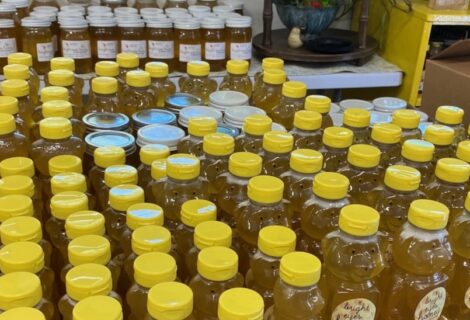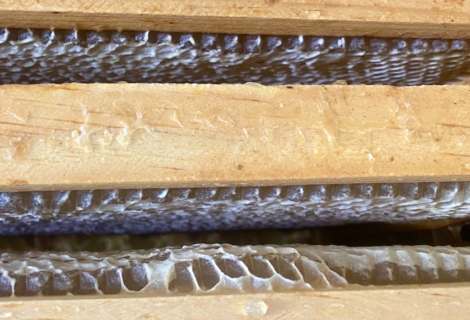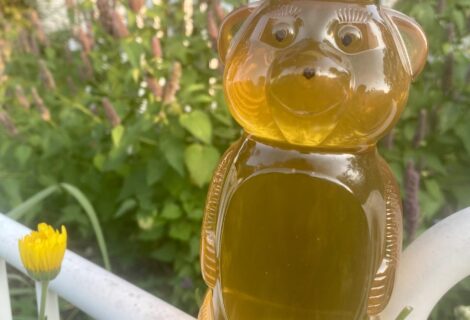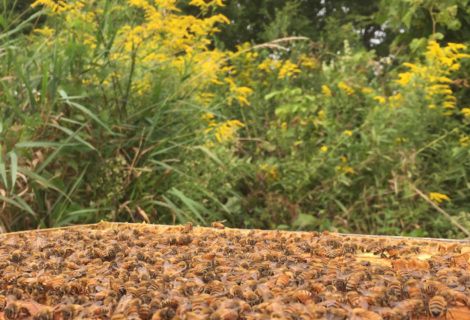The Nectar Flow Is On
When the basswoods bloom, the hummingbirds stop visiting the feeders on the porch because they prefer this nectar source. And so do the bees! But the blooming period is relatively short – only about a week and a half. There are other nectar sources though – that hopefully will hold out for a few more weeks as the stronger colonies continue to fill out their honey supers.
Colony Overview
Two of our 2016 season colonies overwintered and were large enough to split in the spring. I split them in half to create 4 colonies in our IA apiary. During the split process, I also took two frames of bees, brood, and queen cells from the two colonies receiving new queens to create a “nucleus colony”, or nuc for short. Here it is in an old nuc box I had:
They raised their own queen and are doing pretty well so far. I put them into a regular hive in June. Well, almost regular – had to use two shallow boxes to accommodate the deep frames of the nuc since we had no more deep boxes. And two of the “deep” frames were actually mediums that the bees made deeps by attaching perfect honeycomb to the bottom of the frames. That was neat to see. The photo below shows one of the frames with the “foundation-less” piece of free-hanging comb at the bottom of the frame and the transfer of frames happening in the background between the nuc box and the regular hive bodies.
After the transfer, there were a number of bees yet flying into the hive after collecting pollen from the area. These bees stopped to “scent” on their new landing board. In the next photo, you can see some of them with their hind abdominal plates pulled back so their nasinov gland could release the pheromone that communicates to the other bees who were in a holding flight pattern around the hive: “Hey there, yes we know this looks like new digs, but it really is our home. Come on in.”
Together with my folks, we also purchased a number of packages and nucs this year. We discussed hiving them in a prior blog post. Three hives from packages are on our property in MN and four went to our IA yard. We also got a couple later “nucs” – one for my mom on May 18 that is doing well and should make some honey this season. And my dad got a nuc from Manley & Linda Bigalk in June that went to my great, great aunt Arlene’s place near Protivin, IA. Manley runs the Golden Ridge Honey Farm and is a certified Russian honey bee breeder. We’ll keep the Russian stock away from our other yard and see how they overwinter. This colony is not for honey production this year.
The strong
The hives that are doing better are two from the splits that have the original queens and two colonies from 3 lb packages resold from a beekeeper in IA. They have always had a good number of bees flying and they are working on the honey supers. To the left is a tall stacked one now: 4 brood medium boxes, followed by a queen excluder and 3 honey supers.
Then there are a couple mediocre colonies that are doing their thing but taking their time too
The weak
And then their are 4 or so colonies where things are not going quite like we would hope. One package colony never really took off and then it lost its queen. It did make some queen/swarm cells, but they were damaged during the hive inspection that uncovered the issue. I finally got a new queen for it about a week ago and we were able to confirm today that she was released and started laying eggs. It’s going to take another 3 weeks for new workers to start hatching, so it is unclear whether it can build up enough strength to be healthy for going into winter. We will see later whether it needs to be combined with another hive.
Two other colonies have recently decided to replace their queens (one of them may have swarmed). There are not a great number of bees left in those hives and it remains to be seen whether raising their own queens is successful for them in the long run.
And then there is the first package that we hived at our MN home, which has been sick all season. It seems to have a brood disease commonly called sacbrood, where the larvae die, many times after being capped. And then the bees remove the capping to expose the shrunken larvae with a black spot forming on the top.
You can see this phenomenon in a photo I have later. And some of the larvae just dry out and take on a “canoed” shape – dead in the cell.
I got a new queen from a guy who raises them locally and put it in at the same time the other weak colony was re-queened in IA. The reason we tried this is because sometimes this illness can be cleared up with a different queen (read that as different genetics in the hive).
On Sunday, we had a few friends over so we all suited up to see if the new queen was laying. We did see a few eggs, but I suspect they were not viable because we saw capped queen cells on another frame. Unfortunately, it appears the colony rejected the new queen we tried to provide (maybe they were upset I squashed their old one?) and they went ahead with using some of the old queen’s eggs to create new queen cells around. Oh, well – it will still result in different genetics, though not as different as would be the case if they accepted the provided queen.
I’ll try to give an update later in the year on these colonies.
Prairie flower patch update
Last year, we posted about seeding a 4 quadrant patch in our yard with a prairie wildflower mix – a pollinator friendly package from Prairie Moon Nursery. Well, we have a lot of weeds, clover, and other things growing in it, so it is hard to tell if we will see results in a couple years at this point. But either way, it is a pollinator friendly patch in our yard. On Saturday morning, Evan and I walked out there and observed a couple different types of bees active in the patch, besides honey bees.
Lastly, we have zucchini, squash, and pumpkins blooming. Guess who helps pollinate those big flowers? That’s right – the honey bees are in there doing the work God has given them. What a blessing it is!



















Recent Comments